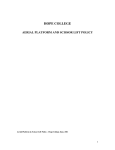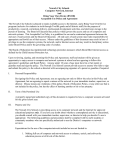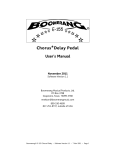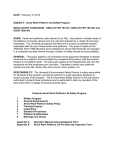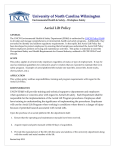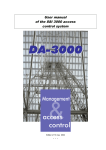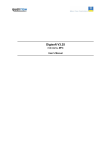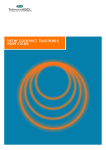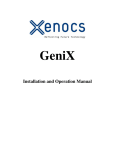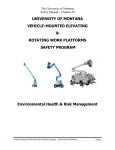Download Aerial Platform Lift Policy - Risk Management
Transcript
Contents I. II. III. IV. V. VI. VII. VIII. IX. Introduction…………………………………….… Scope………………………………………………. Responsibilities………………………………….... Training Program………………………………... Inspections…………………………………….….. Standard Procedures………………………….…. Platform Qualifications……………………….…. Markings and Decals…………………………….. Records Retention………………………………... Appendix A Appendix B Appendix C Page 2 Page 2 Page 2 Page 6 Page 7 Page 9 Page 10 Page 10 Page 11 Operation Manual Acknowledgment Form… Page 12 UND Hydraulic Lift Use and Indemnification Agreement Form………………………. Page 13 Aerial Platform Lift Pre-Start Up Inspection Form…………………………...…….. Page 14 I. Introduction Aerial platform lifts are present throughout the Notre Dame campus and are used and operated by a number of service employees and contractors. The University recognizes that there are a number of potential hazards associated with the use of these aerial platform lifts. This policy is based on the ANSI/SIA A92.6-1999 Standard and is designed to ensure that these lifts are operated in a consistent and safe manner through a system of safety checks and accountability. II. Scope This policy applies to all University-owned equipment designed to elevate personnel on a platform that is propelled by a powered lifting device, with the controls located on the platform itself. It applies to the departments who own the equipment and the employees who use them. Examples of aerial platform lifts include one-man lifts, scissor lifts, boom trucks, cherry pickers, etc. III. Responsibilities a. Risk Management and Safety Responsibilities i. Policy To develop an aerial platform lift policy and revise it when necessary. ii. Training To provide for the training of operators and users of aerial platform lifts , upon requests by departments and to maintain training records. iii. Technical Support To provide technical support to departments and employees when questions or concerns arise with regards to aerial platform lift safety. Aerial Platform Lift Policy - University of Notre Dame Revised January, 2007 2 b. Departmental Responsibilities i. Responsibilities Upon Purchase Upon the purchase of an aerial platform lift, the department shall: 1. Ensure that the operating and maintenance manuals have been received. 2. Acquire repair and parts manuals within 60 days of acquisition. 3. Provide the manufacturer of the lift with the name and address of the university department along with the model and serial number of the lift. 4. Perform an annual inspection on the lift prior to placing the unit in service. 5. Place a copy of the operating and maintenance manuals in a pouch or compartment on the lift. 6. Have all employee operators of the lift review the operating manual, fill out and sign the form titled “Operating Manual Acknowledgment Form” (see Appendix A of this policy) and return it to his/her supervisor for documentation. ii. Maintenance, Inspection and Repair 1. Maintenance: The department responsible for each aerial platform lift shall arrange for maintenance that is appropriate for their lift. The department shall establish a preventive maintenance program based on the manufacturer’s recommendations, the environment it is to be used in and the frequency at which it is to be used. 2. Inspection: The department shall ensure that pre-start inspections, frequent inspections and annual inspections are being performed on the lift (see Section V. of this policy). 3. Repair: When safety related items have been discovered, the lift shall be placed out of service until the item(s) has been repaired. All replacement parts or components that are replaced shall be identical to or equivalent to the original parts based on information provided by the manufacturer or supplier. Aerial Platform Lift Policy - University of Notre Dame Revised January, 2007 3 iii. Training The department is responsible for arranging for the training of all authorized users of the lift through the Risk Management and Safety Department. No personnel shall operate or ride on an aerial platform lift if they have not been trained. (see section IV of this policy). The department shall insure that aerial platform lift maintenance is performed only by personnel who are trained in aerial lift maintenance. iv. Selling, donating lifts Prior to the donation or sale of an aerial platform lift the donating or selling department shall contact Risk Management and Safety to ensure that appropriate steps are taken. v. Responsibilities Involving Contractors Departments are responsible for conveying certain information to contractors who use university-owned aerial platform lifts to ensure compliance and safety on University property. The following criteria shall be met when contractors borrow lifts: 1. Only employees of contractors who are approved to perform work at Notre Dame may be permitted to borrow aerial platform lifts. 2. Require the employee(s) of the contractor company to review and sign the form titled “UND Hydraulic Lift Use Waiver and Indemnification Agreement” (see Appendix B). 3. Inform the contracting company that only properly trained personnel may operate or work on the lift. 4. Perform a frequent inspection on the lift upon the return of the lift. vi. Records Retention Each department shall date and retain the following records for each aerial platform lift they own: 1. Serial number and date of purchase (this shall be kept for as long as the department owns the lift. Aerial Platform Lift Policy - University of Notre Dame Revised January, 2007 4 2. Written records of the frequent and annual inspections and repairs performed. This shall include deficiencies found, corrective actions taken and the identification of the person(s) who performed the inspection and repairs. 3. Written records of repairs made on the lift. 4. Training records for any employees trained in the maintenance of the aerial platform lift. c. Employee/User Responsibilities Because the user has direct control over the application and operation of aerial platform lifts, conformance with good safety practices in this area is the responsibility of the user and the operating personnel. Decisions on the use and operation of the lift shall be made with the understanding that the platform will be carrying personnel whose safety is dependent on those decisions. Users and operators of aerial platform lifts have responsibilities involving the following: i. Manuals Users of aerial platform lifts must review and acknowledge that they have reviewed the operating manuals for all lifts that they use. Documentation of this shall be established by having the employee review and sign the form titled “Operating Manual Acknowledgement Form (see Appendix A). The user is expected to know and understand the following about the lift he/she operates prior to initial operation of the lift: 1. The operation of the lift. 2. All control features of the lift. 3. All placard warnings. 4. All safety devices on the lift. 5. Where to locate the user manual. 6. Who can operate or use the platform lift. If the user does not understand any of the above he/she shall consult with his/her supervisor prior to using the lift. Aerial Platform Lift Policy - University of Notre Dame Revised January, 2007 5 ii. Inspection and Maintenance Users shall inspect and maintain the aerial platform as required by their department to ensure proper operation. Note that some employees may be approved by their department to operate but not to perform maintenance on the lifts. However, all users shall perform pre-start inspections (see Section V. of this policy) on the lift prior to each day’s use of the lift. Documentation of the pre-start inspections shall be done by completing an “Aerial Platform Lift Pre-Start Inspection Form” (see Appendix C for the form). Aerial platform lifts that are not in proper operating condition shall be immediately removed from service and reported to the appropriate departmental supervisor. Only employees who are authorized by their department may perform maintenance duties on the lifts. iii. Workplace Inspections Prior to setting up the lift at each new location the user shall conduct a workplace Inspection to identify potential hazards. See “Inspections”, Section V. of this policy. iv. Training Only trained employees may operate or use aerial platform lifts (see “Training Program” in Section IV. of this policy). Likewise, only trained and authorized employees may perform maintenance duties on the lifts. IV. Training Program All operators and users of aerial platform lifts shall attend an aerial lift training session sponsored by the Risk Management and Safety Department. The contents of the training will include the following: a. Purpose and use of manuals. b. Pre-start inspection process. c. Identification of malfunctions and problems. d. Factors affecting stability. e. Purpose of placards and decals. f. Workplace inspections. g. Safety rules and regulations. Aerial Platform Lift Policy - University of Notre Dame Revised January, 2007 6 h. Authorization to operate. i. Operator warnings and instructions. j. Operation of the aerial platform. k. Demonstrate competency. V. Inspections The inspection process is a critical step in preventing aerial lift accidents that are caused from faulty or worn out equipment. Aerial platform lifts that are not in proper operating condition shall be removed from service until the problems have been corrected by an authorized and trained maintenance technician. a. Pre-Start Inspections Before each day’s use or at the beginning of each shift that the aerial platform lift is used it shall be given a pre-start inspection which is a visual inspection and functional test that includes the following criteria: i. Operating and emergency controls. ii. Safety devices. iii. Personal protective devices. iv. Air, hydraulic and fuel system leaks. v. Cables and wiring harness. vi. Loose or missing parts. vii. Tires and wheels. viii. Placards, warnings, control markings and operating manual(s). ix. Outriggers, stabilizers and other structures. x. Guardrail system. xi. Other items specified by manufacturer. Aerial Platform Lift Policy - University of Notre Dame Revised January, 2007 7 b. Frequent Inspections Any time an aerial platform lift has not been used for a period of 3 months or more (or after the lift has been purchased) a frequent inspection shall be performed by a qualified person and shall include the following: i. All functions and their controls for speed(s) smoothness, and limits of motion. ii. Lower controls including the provisions for overriding of upper controls. iii. All chain and cable mechanisms for adjustment, wear or damaged parts. iv. All emergency and safety devices. v. Lubrication of all moving parts, inspection of filter element(s), hydraulic oil, engine oil, and coolant as specified by the manufacturer. vi. Visual inspection of structural components and other critical components such as fasteners, pins, shafts and locking devices. vii. Placard, warnings and control markings. viii. Additional items specified by the manufacturer. c. Annual Inspections An annual inspection shall be performed on each aerial platform lift each year. The inspection shall be performed by a qualified mechanic who is authorized to perform maintenance duties on the lift. The inspection shall include all items specified by the manufacturer for an annual inspection. d. Workplace Inspections Before an aerial platform lift is used and during it’s use, the operator shall check the area in which the aerial platform lift is to be used for possible hazards such as, but not limited to: i. Drop-offs or holes. ii. Slopes. iii. Bumps and floor obstructions. iv. Debris. Aerial Platform Lift Policy - University of Notre Dame Revised January, 2007 8 v. Overhead obstructions and high voltage conductors. vi. Hazardous locations and atmospheres. vii. Inadequate surface and support to withstand all load forces imposed by the aerial platform lift. viii. Wind and weather conditions. ix. Presence of unauthorized people. x. Other possible unsafe conditions. VI. Standard Procedures To ensure safe practices, the following general procedure is used when an authorized user uses an aerial platform lift: a. Obtain any necessary authorization to use the lift. b. Check the last pre-start inspection for any comments or notes. c. Perform a pre-start inspection on the lift, document the inspection and place it in the reserved storage location on the lift. d. Perform a workplace inspection in the area that the lift will be used. e. Extend and adjust the outriggers, stabilizers, extendible axles, or other stability enhancing means. f. Ensure that the guardrails are installed and are in place. g. Ensure that the load being placed on the lift is within the rated capacity of the lift. h. Test the controls of the lift. i. Ensure that all personnel on the lift have been trained and authorized to operate or work on the platform. Aerial Platform Lift Policy - University of Notre Dame Revised January, 2007 9 VII. Platform Qualifications a. Specifications for platforms The following criteria shall be met to be an approved platform on a lift: i. Platform width shall be not less than 18 inches and shall have a slip resistant surface. ii. The platform shall have a guardrail system around its periphery. It is removable or can be lowered. The means used to secure it in the normal operating position shall be readily accessible for inspection and maintenance. iii. The guardrail system shall include a top rail that is between 39 and 45 inches high, a mid rail that is approximately half-way from the platform to the top rail, and a toe board that is at least 4 inches high. b. When to use personal fall protection When operating articulating, or boom type lifts that are equipped with lanyard tie off points, the use of fall protection equipment is required. If special circumstances exist that encourage the operator to use fall protection on vertical aerial platform lifts, they must tie off to a proper tie off point that is not attached to or part of the aerial platform lift itself. VIII. Markings and Decals In addition to any other markings or decals that are placed on the lift by the manufacturer, the following information shall be displayed on all aerial platform lifts in a clearly visible, accessible area and in a durable manner: a. The make, model, serial number, and manufacturer’s name and address. b. The rated workload, including rated number of occupants. c. The maximum platform height. Aerial Platform Lift Policy - University of Notre Dame Revised January, 2007 10 IX. Records Retention Maintenance, inspection and training records shall be maintained for equipment and its operators. Training records shall be maintained by Risk Management and Safety for a period of Five years. The following records shall be maintained by each department who owns an aerial platform lift: a. Workplace inspection documents shall be maintained for a period of one year. b. Pre-start inspection documents shall be maintained for a period of two years. c. Frequent and Annual inspection documentation shall be maintained for the entire ownership of the lift. Aerial Platform Lift Policy - University of Notre Dame Revised January, 2007 11 Appendix A Operating Manual Acknowledgement Form By signing this document I am certifying that I have received a copy of the operations manual for the aerial platform lift shown below. Upon training and authorization by my department, I am expected to operate this lift. I understand that it is my responsibility to review and understand the safe operation of this aerial platform lift based on the training I receive and the manufacturer’s recommendations. I understand that if, at any time, I have any questions regarding the information found in the user’s manual I can contact Risk Management and Safety, my supervisor or the manufacturer to obtain my answers. Aerial Lift Make Aerial Lift Model Name (print) Department User/Operator’s name (sign) Date Aerial Platform Lift Policy - University of Notre Dame Revised January, 2007 12 Appendix B UND HYDRAULIC LIFT USE WAIVER AND INDEMNIFICATION AGREEEMENT I, , being of legal age, am employed by who is doing business with the University of Notre Dame du Lac, (“the University”). The University owns certain hydraulic personnel lifts (“the Lift”) which I desire to use. I understand and acknowledge that I am not required to use the Lift and that my use of the Lift is wholly voluntary. I acknowledge that the University will not provide training for use of the Lift, that the University has available operating instructions for the life I wish to use, and warrant that I have sufficient training, knowledge and experience to operate it safely. In consideration of the University’s agreement to permit me to use the Lift, the receipt and sufficiency of which consideration is hereby acknowledged, I agree as follows: 1). I, individually, and on behalf of my heirs, successors, assigns and personal representatives, hereby release acquit and forever discharge the University and its employees, agents, servants, officers, trustees and representatives (in their office and individual capacities) form any and all liability whatsoever for any and all damages, losses or injuries (including death) to persons or property or both, including but not limited to any claims, demands, actions, causes of action, damages, costs, expenses and/or attorneys fees, which arise out of, occur during, or result from my use of the Lift on University property. 2). I, individually, and on behalf of my heirs, successors, assigns and personal representatives, hereby agree to indemnify, defend and hold harmless the University and its employees, agents, servants, officers, trustees and representatives (in their official and individual capacities) from any and all liability, loss or damage that they or any of them incur or sustain as a result of any claims, demands, actions, causes of action, judgments, costs or expenses, including attorneys fees, which arise out of, occur during, or result from my use of the Lift on University property. 3). I agree that this Wavier, release and Indemnification Agreement is to be construed under the laws of the State of Indiana, that it is intended to be as broad and inclusive as permitted by the laws of the State of Indiana, and that if any portion hereof is held invalid, the balance hereof shall, notwithstanding, continue in full legal force and effect. 4). I hereby acknowledge and accept that there are certain risks, including bodily injury and death, inherent in operating the Lift. I acknowledge that I have read the operating instructions for use of the Lift and I understand how to operate the same. I have knowingly and voluntarily decided to assume the risk of these inherent dangers in consideration of the University’s permission to allow me to use the Lift on University property. 5). I hereby warrant that I am currently covered by my employer’s policy of worker’s compensation insurance and that I am and will be acting in the scope of my employment and for my employer’s sole benefit in operation the Lift at all times. 6). In signing this Waiver and Release I hereby acknowledge and represent that I have read this entire document, that I understand its terms and provisions, that by signing it I am giving up substantial legal rights I might otherwise have, that it is a binding agreement, and that I have signed it knowingly and voluntarily. Name (Printed) Signature Date Aerial Platform Lift Policy - University of Notre Dame Revised January, 2007 13 Appendix C Aerial Platform Lift Pre-start Inspection form The pre-start inspection shall be performed prior to each day’s or shift’s use of the aerial platform lift by an authorized and trained user of the lift. Documentation of the inspection shall be maintained by each department, with a copy of the most recent inspection document stored on the lift. Check off the items that have been inspected or mark the N/A box if the item does not apply to the lift being inspected. Place any comments in the space provided below. If there are any of these items that are not satisfactory place the lift out of service until the item is corrected. Department lift belongs to: Make of lift: Model of lift: Serial #: Inspector’s Name Date of Inspection Item Inspected Okay Not Okay N/A Operating controls Emergency controls Safety devices Personal protective devices Pneumatic system (leaks) Hydraulic system (leaks) Fuel system (leaks) Cables Wiring harness Loose/missing parts (locking pins/bolts…) Tires and wheels Placards and Warnings Operational Manual Outriggers/Stabilizers Guardrail system and locking gate Other items Comments: Inspector’s Signature Date Aerial Platform Lift Policy - University of Notre Dame Revised January, 2007 14














